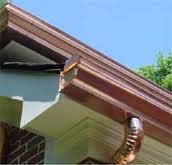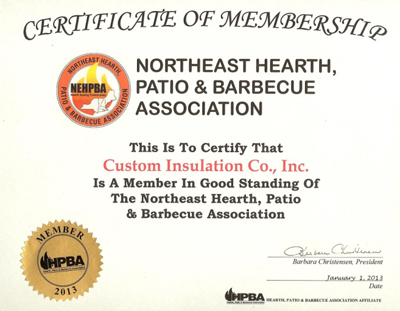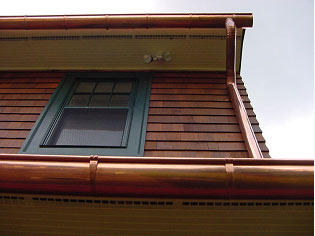
Call Us Today!
508-488-9999
Home Blown-in Insulation & Gutter Solutions
29 April 2013
 If you are building a home or remodeling your existing home and are trying to make green construction choices, consider that the greenest choice for a gutter system is copper gutters. Why? Because copper is one of only a few materials that is fully sustainable. Only 12% of the copper reserves have been mined and most of what has been mined is still in use. It is also estimated that 55% of all the copper used for architectural purposes today is recycled.
If you are building a home or remodeling your existing home and are trying to make green construction choices, consider that the greenest choice for a gutter system is copper gutters. Why? Because copper is one of only a few materials that is fully sustainable. Only 12% of the copper reserves have been mined and most of what has been mined is still in use. It is also estimated that 55% of all the copper used for architectural purposes today is recycled.
Copper is an incredibly durable building material, which makes it an excellent choice for parts of home construction that will be subject to excessive wear and tear. Your copper gutters will last at least 100 years. Once you install them on your home, you will never replace them. There is no other gutter system or gutter material that you can say this about. Although the price of copper gutters is more than aluminum, your aluminum gutters will not last nearly as long, and will incur far more maintenance and repair costs.
Copper gutters are virtually maintenance free. Although a copper gutter system will require the regular debris removal that all gutter systems occasionally need, copper gutters will not need to be repainted or replaced over their lifespan. With the natural properties of copper gutters that work as a fungicide and algaecide, they also naturally eliminate one of the biggest causes of clogged gutters: moss.
For more information on copper gutters for your Boston or Worcester area home, contact Custom Insulation.
24 April 2013
Custom Insulation Co., Inc. is proud to be a member of the Northeast Hearth, Patio & Barbecue Association and, by affiliation, with the nationally known HPBA.

The Northeast Hearth, Patio & Barbecue Association (NEHPBA) is a not-for-profit trade association, and is known throughout the Northeast for promoting Safety, Quality & National Fire Institution (NFI) Certification Training.
Custom Insulation Co., Inc. is always striving to bring our Quality & Service to the highest possible level. As part of our “Continuous Improvement” philosophy, we will be working with NEHPBA over the coming months to bring even greater value to you, our customer.
22 April 2013
April showers bring May flowers. But in Boston and Worcester, it often rains more in May, so now is the time to replaces the gutters if needed. Consider copper gutters, so you will never have to think about gutter care or maintenance again. Even better, copper gutters are a green option, and they will increase the value of your home.
Better than any other type of gutters, copper gutters can stand up to whatever type of weather that comes your way.
With copper gutters you can add a value and a distinct style to your home that aluminum gutters just can’t provide. Copper is immediately noticeable and add unique visual appeal.
Copper gutters require less maintenance than aluminum gutters but they still protect homes from water damage, and they look great doing it.
Of course, copper gutters are more expensive than aluminum gutters, but there are no maintenance costs and they last a lifetime. Combined with the resale value they add to your home, you will surely make the additional expense up over time.
Every home needs a gutter system, copper gutters are the best choice. If you are looking for a beautiful gutter system to stand up to the elements, that lasts a lifetime, and is maintenance free, contact Custom Insulation.
17 April 2013
With a tight economy, many homeowners are looking for ways to cut costs. Heating and cooling costs can be the biggest expenditures in our homes by far. With summer approaching it is still time to think about upgrading the insulation in your home. Adding insulation, along with sealing air leaks, is one of the most cost-effective energy-saving home improvements you can make to an existing home. In fact, just doing this can cut heating and cooling costs by at least 15%, often more.
According to the department of commerce, there is a basic rule of insulating that is the same for each and every home: "install insulation on any surface separating a heated space from an unheated space—attics, walls, basement walls, floors and crawl spaces".
Even if your home already has insulation in these areas, it can be very beneficial in saving on energy costs to add more insulation, especially adding attic insulation. Sealing air leaks around vents, chimneys, wires, and light fixtures should also be done when you add the additional insulation for the best results.
If you think that you are spending too much on energy costs, an energy assessment of your home can be done which should include an insulation inspection which will tell you how much insulation you have and how much more you need. The amount of insulation, which is measured in R-values, and the type of insulation that is best for your home, will vary for every home. The amount you need also depends on:
The colder weather zones like Boston and Worcester call for higher R-values. For more information on adding insulation to your existing home, contact Custom Insulation.
10 April 2013
The average home in Boston and Worcester consumes almost 49% more energy than it did in 1990. Fortunately there are lots of ways to reduce your home energy bills. By conserving energy in your home you can save money, help conserve fuel resources, and promote a cleaner environment.
With the average home using this much more electricity and combined with the costs rising yearly, it is important to look at ways to cut home heating costs.
One of the best ways to save money is to ensure that your home has the right amount of insulation. If your roof or attic is not insulated properly you can lose around 30% of the heat. Areas of heat loss in a home include: flue, roof, and ventilation, loss through walls, window and floor loss. Adding loft or attic insulation can reduce your heating bills by 20%.
Homes also lose heat through windows and walls. If double glazing is too expensive consider using film. It is also a good idea to make sure your water heater is insulated.
For more information on improving your home insulation, contact Custom Insulation.
1 April 2013
Improving home insulation could be getting overlooked in favor of wood burning stoves. While the intent behind wood stoves is for greener living, when there is poor insulation, adding a wood burning stove to our home doesn’t necessarily mean we’re living greener or making our homes more energy efficient.
There has been a large increase in wood burning stove sales over the last 2 years. Wood burning stoves are fashionable and popular right now, for good reason. The cold winters, rising energy prices and the recession that is putting a strain on wallets, along with the desire for green living have all fueled demand for wood burning stoves.
However, it could be the case that better home insulation could make homes considerably warmer and reduce the need to for a new heat source. Without the right insulation in your home, even after a wood burning stove has been installed all that extra heat will be lost.
Insulation is about having a draft free, efficient home that is warm in the winter and cool in the summer. The right insulation helps you get the most benefit out of your home heating and cooling systems while hopefully reducing your energy bills.
Wood burning stoves are a great and attractive way to heat your home. They are a greener alternative and they use biofuel, all of these features make them attractive. However, without the right insulation in your home, you will still waste money and you still won’t be warm in the winter.
For more information on home insulation in Boston or Worcester, contact Custom Insulation.
25 March 2013
In new construction, insulating your home properly saves you money on heating and cooling bills and improves the comfort of your home at the same time. You have several choices for insulation, what type you choose depends on your climate and how your home is constructed
Here are specifics on where to insulate your home in Boston and Worcester.
1. In unfinished attics, insulate between and over the floor joists to seal off living spaces below. As well as the attic access door
2. All exterior walls, including the walls between living spaces and unheated garages, or storage areas; foundation walls above ground level; foundation walls in heated basements, and full interior or exterior walls.
3. Floors above cold spaces, such as vented crawl spaces and garages. Also insulate any portion of the floor in a room that extends beyond the exterior wall below; slab floors built directly on the ground; as an alternative to floor insulation, foundation walls of unvented crawl spaces. Extend insulation into joist space to reduce air flows.
4. Band joists. An uninsulated band joist can account for a significant portion of a building's heat loss.
5. Replacement or storm windows and caulk and seal around all windows and doors.
For more information on insulation for new home construction, contact Custom Insulation.
21 March 2013
If you are building a home or adding an addition, you have plenty of choices for insulation including, spray foam, batt, cellulose and blown-in. While all types of insulation works well, many feel as though cellulose is the best choice for old and new construction. Cellulose insulation gives you the most bang for your buck.
Cellulose insulation is exceptionally green-friendly, made from recycled newspapers. This makes it economical option. But besides being economical and organic, recycled cellulose insulation out performs fiberglass insulation and is less expensive than spray-foam. Builders have been looking for a better solution to fiberglass insulation and cellulose is it. Why? Because when using cellulose insulation, the entire building envelope of your home is sealed.
Cellulose is cheaper than spray foam and is more effective than fiberglass insulation. Dense packed cellulose has an R-Value of 4.0 per inch and wicks moisture better than any other insulation. For air infiltration and sound control, cellulose insulation is a better choice than fiberglass or spray foam.
For more information on wet spray cellulose insulation for your new construction or remodeling project in Worcester, contact Custom Insulation.
11 March 2013
In the older homes around Worcester and Boston, many people wonder where to spend home rehabilitation money. Insulation is a great place to spend money if you want to save money.
The best place for insulation is in the attic floor, not in the walls. Also, if there's a drop stair or a door to the attic, make sure it's insulated and sealed too.
Once that's done, the attic should be properly ventilated. Insulation lets the attic stay near the outside temperature in the wintertime. The ventilation and insulation let the attic space stay near the outside temperature of the summertime too.
If a historic house needs attic insulation, have a contractor put 1 to 2 inches of expanded foam sheeting down over the old floor, then put half-inch plywood flooring on it and use long screws to join the sandwich to the old attic floor. The attic itself is then separated from the building envelope.
Around the sills, between floor joists, is another place where it's essential to insulate. Batt insulation placed there with the shiny metal facing the inside of the basement also act as firebreaks, preventing a fire in the basement of an older balloon-framed house from spreading due to the chimney effect of the tall empty spaces between the studs.
For more information on adding insulation to older or historic homes, contact Custom Insulation.
Excerpts myeasternshoremd.com
5 March 2013
 Building a home? If so, you can set your new home apart from the others, while also cutting down on home maintenance costs down the road. How? With copper gutters. But even better, if you are trying to make your home as “green” as possible, copper gutters do that too!
Building a home? If so, you can set your new home apart from the others, while also cutting down on home maintenance costs down the road. How? With copper gutters. But even better, if you are trying to make your home as “green” as possible, copper gutters do that too!
Copper gutters add a level of class and quality to your home that is a step above the rest. They have a look to them that is far beyond what aluminum gutters will provide, showcasing your home with the flare you are looking for.
Copper gutters are also low maintenance. They will last forever because they will never rust or rot; whatever the weather copper gutters can withstand it. As a result copper gutters are much easier to maintain than vinyl. Copper is one of the most resilient materials you can choose to protect your home from water.
Copper gutters are also a green product because most, if not all, of the copper used is recycled. But they also have durability and longevity with a lifespan of at least 100 years.
When you require functionality, aesthetic and performance from your gutter system, contact Custom Insulation about copper gutters.